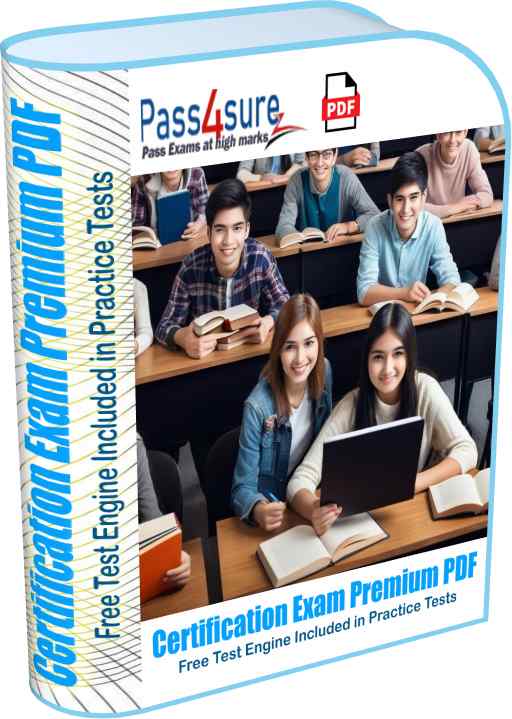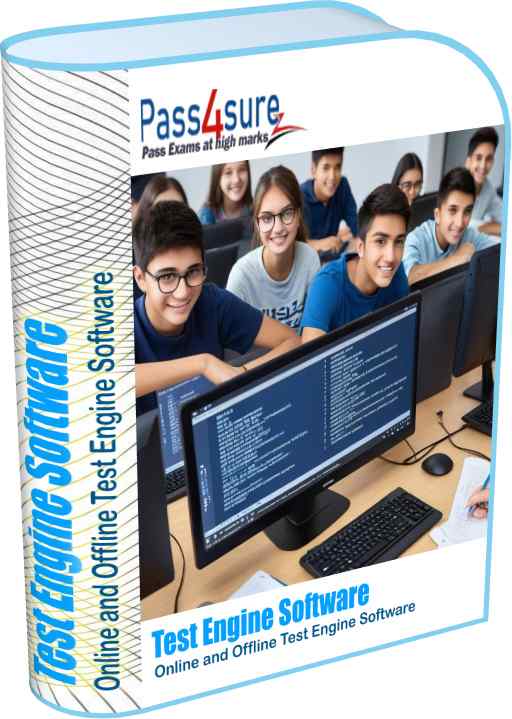| Exam Code | 312-92 |
| Questions and Answers | 99 |
| Premium Access | Yes |
| Online Test Engine | Yes |
| Comprehensive Q&A | Yes |
| Success Rate | 98% |
| Real Questions | Yes |
| Updated Regularly | Yes |
| Portable Files | ✔ |
| Unlimited Download | ✔ |
| 100% Secured | ✔ |
| Confidentiality | 100% |
| Success Guarantee | 100% |
| Any Hidden Cost | $0.00 |
| Auto Recharge | No |
| Updates Intimation | by Email |
| Technical Support | Free |
| PDF Compatibility | Windows, Android, iOS, Linux |
| Test Engine Compatibility | Mac/Windows/Android/iOS/Linux |
| Sample Questions |  |
Pass4sure Practice Tests are an effective way to prepare for the 312-92 exam. The practice tests include premium PDF and Test Engine Software. Pass4surez.in provides an extensive question bank to improve your knowledge and help you achieve high marks on the 312-92 exam.
The EC-Council Certified Secure Programmer v2 (CSP) exam questions and answers on Pass4surez.in are regularly verified and updated to ensure they reflect the latest syllabus and topics covered in the real test. The certification exams and entry test exams from pass4surez.com make you familiar with the test environment. The goal is to enhance your knowledge of the 312-92 exam and enable you to pass it on your first attempt.
The PDF of 312-92 exam questions and answers provided by Pass4surez.in contains a comprehensive pool of questions and verified answers, including references and explanations where applicable. The objective is not only to help you pass the exam, but also to significantly improve your knowledge of the latest 312-92 course topics.
 |
|
CERTIFICATION EXAM PREMIUM PDF
Pass4Sure provide premium PDF that contains all the questions and answers that are necessary to make your concepts about the exam topics clear and boost your knowledge about the exam. These questions and answers make you ready to face actual test in test centers. Our team keep on revising material and update the exam questions accordingly. You will feel confident in test center. Our support team keep on helping our customers to make their testing experience best. Our premium PDF files are searchable, convertable and printable at high quality to make book that you can study during traveling or during vacations. Our automated system sends intimation email to our customers on each update. The files in customer download section is overwritten with latest pdf files.
|
| |
|
 |
|
CERTIFICATION EXAM TEST ENGINE
Pass4sure test engine is best certification and examination preparation tool that help you make yourself ready to take the actual exam and get high marks in the exam. Our OTE (Online Test Engine) support all OS Platforms including iOS, Android, Windows, Linux, Chromebook etc and provide up to date experience to get ready for actual test. Our Offline Test Engine is compatible to all windows platforms including latest windows versions. Our test engines helps to familiarize actual test environment and makes you ready to take timed tests. Your performance history and graphs helps you to see when you are ready to sit in actual exam in test center. These test engines uses up to date and latest questions and answers, keeps on updating the questions pool and sends you intimation on each update.
|
Pass4sure Premium PDF and Test Engines support all platforms and devices including mobile devices and computers. You should download sample PDF and Test Engine to evaluate the product before you buy the full version. Our exam samples include some questions that may be or may not be up to date but full version is always up to date.
Software defects, bugs, and flaws in the logic of the program are consistently the cause for software vulnerabilities. Analysis by software security professionals has proven that most vulnerabilities are due to
errors in programming. Hence, it has become crucial for organizations to educate their software developers about secure coding practices.
Attackers scan for security vulnerabilities in applications and servers and attempt to use these vulnerabilities to steal secrets, corrupt programs and data, and gain control of computer systems and networks. Sound programming techniques and best practices should be used to develop high quality code to prevent web application attacks. Secure programming is a defensive measure against attacks targeted towards application systems.
ECSP-Java is comprehensive course that provides hands-on training covering Java security features, policies, strengths, and weaknesses. It helps developers understand how to write secure and robust Java applications and provides advanced knowledge in various aspects of secure Java development that can effectively prevent hostile and buggy code. The end result of security Java coding practices include saving valuable effort, money, time, and possibly the reputation of organizations using Javacoded applications.
Students in this course will acquire knowledge in the following areas:
Java security principles and secure coding practices
Java Security Platform, Sandbox, JVM, Class loading, Bytecode verifier, Security Manager, security policies, and Java Security Framework
Secure Software Development Lifecycle, threat modelling, software security frameworks, and secure software architectures
Java Authentication and Authorization Service (JAAS), its architecture, Pluggable Authentication
Module (PAM) Framework, and access permissions through Java Security Model
Secure Java concurrency and session management that includes Java Memory Model, Java
Thread Implementation methods, secure coding practices, and guidelines for handling threads, race conditions, and deadlocks
Core security coding practices of Java Cryptography that includes Encryption, KeyGenerator, implementation of Cipher Class, Digital Signatures, Secret Keys, and key management
Various Java application vulnerabilities such as Cross-Site Scripting (XSS), Cross Site Request
Forgery (CSRF), Directory Traversal vulnerability, HTTP Response Splitting attack, Parameter
Manipulation, Injection Attacks and their countermeasures
Coding testing and review techniques and practices
Best practices and standards and guidelines for secure file input/output and serialization
Java input validation techniques, validation errors, and best practices
Java exceptions, erroneous behaviors, and the best practices to handle or avoid them
Secure authentication and authorization processes
• Vulnerability Disclosure Growth
• Impact of Vulnerabilities and Associated Costs
• Security Incidents
• Software Security Failure Costs
• Need for Secure Coding
• Java Security Overview
• Java Security Platform
• Java Virtual Machine (JVM)
• Class Loading
• Bytecode Verifier
• Class Files
• Security Manager
• Java Security Policy
• Java Security Framework
• Why Secured Software Development is needed?
• Why Security Bugs in SDLC?
• Characteristics of a Secured Software
• Security Enhanced Software Development Life Cycle
• Software Security Framework
• Secure Architecture and Design
• Design Principles for Secure Software Development
• Guidelines for Designing Secure Software
• Threat Modeling
• Threat Modeling Approaches
• Web Application Model
• Threat Modeling Process
• SDL Threat Modeling Tool
• Secure Design Considerations
• Secure Java Patterns and Design Strategies
• Secure Java Coding Patterns
• Secure Code Patterns for Java Applications
• Secure Coding Guidelines
• System Quality Requirements Engineering
• System Quality Requirements Engineering Steps
• Software Security Testing
• Secure Code Review
• Step 1: Identify Security Code Review Objectives
• Step 2: Perform Preliminary Scan
• Step 3: Review Code for Security Issues
• Step 4: Review for Security Issues Unique to the Architecture
• Code Review
• Source Code Analysis Tools
• Advantages and Disadvantages of Static Code Analysis
• Advantages and Disadvantages of Dynamic Code Analysis
• LAPSE: Web Application Security Scanner for Java
• FindBugs: Find Bugs in Java Programs
• Coverity Static Analysis
• Coverity Dynamic Analysis
• Veracode Static Analysis Tool
• Source Code Analysis Tools For Java
• Fuzz Testing
• File Input and Output in Java
• The java.io package
• Character and Byte Streams in Java
• Reader and Writer
• Input and Output Streams
• All File creations should Accompany Proper Access Privileges
• Handle File-related Errors cautiously
• All used Temporary Files should be removed before Program Termination
• Release Resources used in Program before its Termination
• Prevent exposing Buffers to Untrusted Code
• Multiple Buffered Wrappers should not be created on a single InputStream
• Capture Return Values from a method that reads a Byte or Character to an Int
• Avoid using write() Method for Integer Outputs ranging from 0 to 255
• Ensure Reading Array is fully filled when using read() Method to Write in another Array
• Raw Binary Data should not be read as Character Data
• Ensure little endian data is represented using read/write methods
• Ensure proper File Cleanup when a Program Terminates
• File Input/Output Best Practices
• File Input and Output Guidelines
• Serialization
• Implementation Methods of Serialization
• Serialization Best Practices
• Secure Coding Guidelines in Serialization
• Percentage of Web Applications Containing Input Validation Vulnerabilities
• Input Validation Pattern
• Validation and Security Issues
• Impact of Invalid Data Input
• Data Validation Techniques
• Whitelisting vs. Blacklisting
• Input Validation using Frameworks and APIs
• Regular Expressions
• Vulnerable and Secure Code for Regular Expressions
• Servlet Filters
• Struts Validator
• Struts Validation and Security
• Data Validation using Struts Validator
• Avoid Duplication of Validation Forms
• Struts Validator Class
• Enable the Struts Validator
• Secure and Insecure Struts Validator Code
• HTML Encoding
• Vulnerable and Secure Code for HTML Encoding
• Vulnerable and Secure Code for Prepared Statement
• CAPTCHA
• Stored Procedures
• Character Encoding
• Input Validation Errors
• Best Practices for Input Validation
• Exception and Error Handling
• Example of an Exception
• Handling Exceptions in Java
• Exception Classes Hierarchy
• Exceptions and Threats
• Erroneous Exceptional Behaviors
• Dos and Donts in Exception Handling
• Best Practices for Handling Exceptions in Java
• Logging in Java
• Example for Logging Exceptions
• Logging Levels
• Log4j and Java Logging API
• Java Logging using Log4j
• Vulnerabilities in Logging
• Logging: Vulnerable Code and Secure Code
• Secured Practices in Logging
• Percentage of Web Applications Containing Authentication Vulnerabilities
• Percentage of Web Applications Containing Authorization Bypass Vulnerabilities
• Introduction to Authentication
• Java Container Authentication
• Authentication Mechanism Implementation
• Declarative v/s Programmatic Authentication
• Declarative Security Implementation
• Programmatic Security Implementation
• Java EE Authentication Implementation Example
• Basic Authentication
• How to Implement Basic Authentication?
• Form-Based Authentication
• Form-Based Authentication Implementation
• Implementing Kerberos Based Authentication
• Secured Kerberos Implementation
• Configuring Tomcat User Authentication Setup
• Client Certificate Authentication in Apache Tomcat
• Client Certificate Authentication
• Certificate Generation with Keytool
• Implementing Encryption and Certificates in Client Application
• Authentication Weaknesses and Preventio
• Introduction to Authorization
• JEE Based Authorization
• Access Control Model
• Discretionary Access Control (DAC)
• Mandatory Access Control (MAC)
• Role-based Access Control (RBAC)
• Servlet Container
• Authorizing users by Servlets
• Securing Java Web Applications
• Session Management in Web Applications
• EJB Authorization Controls
• Common Mistakes
• Java Authentication and Authorization (JAAS)
• JAAS Features
• JAAS Architecture
• Pluggable Authentication Module (PAM) Framework
• JAAS Classes
• JAAS Subject and Principal
• Authentication in JAAS
• Subject Methods doAs() and doAsPrivileged()
• Impersonation in JAAS
• JAAS Permissions
• LoginContext in JAAS
• JAAS Configuration
• Locating JAAS Configuration File
• JAAS CallbackHandler and Callbacks
• Login to Standalone Application
• JAAS Client
• LoginModule Implementation in JAAS
• Phases in Login Process
• Java EE Application Architecture
• Java EE Servers as Code Hosts
• Tomcat Security Configuration
• Best Practices for Securing Tomcat
• Declaring Roles
• HTTP Authentication Schemes
• Securing EJBs
• Percentage of Web Applications Containing a Session Management Vulnerability
• Java Concurrency/ Multithreading
• Concurrency in Java
• Different States of a Thread
• Java Memory Model: Communication between Memory of the Threads and the Main Memory
• Creating a Thread
• Thread Implementation Methods
• Threads Pools with the Executor Framework
• Concurrency Issues
• Do not use Threads Directly
• Avoid calling Thread.run() Method directly
• Use ThreadPool instead of Thread Group
• Use notify all() for Waiting Threads
• Call await() and wait() methods within a Loop
• Avoid using Thread.stop()
• Gracefully Degrade Service using Thread Pools
• Use Exception Handler in Thread Pool
• Avoid Overriding Thread-Safe Methods with the non ThreadSafe Methods
• Use this Reference with caution during Object Construction
• Avoid using Background Threads while Class Initialization
• Avoid Publishing Partially Initialized Objects
• Race Condition
• Secure and Insecure Race Condition Code
• Deadlock
• Avoid Synchronizing high level Concurrency Objects using Intrinsic Locks
• Avoid Synchronizing Collection View if the program can access Backing Collection
• Synchronize Access to Vulnerable Static fields prone to Modifications
• Avoid using an Instance Lock to Protect Shared Static Data
• Avoid multiple threads Request and Release Locks in Different Order
• Release Actively held Locks in Exceptional Conditions
• Ensure Programs do not Block Operations while Holding Lock
• Use appropriate Double Checked Locking Idiom forms
• Class Objects that are Returned by getClass() should not be Synchronized
• Synchronize Classes with private final lock Objects that Interact with Untrusted Code
• Objects that may be Reused should not be Synchronized
• Be Cautious while using Classes on Client Side that do not Stick to their Locking Strategy
• Deadlock Prevention Techniques
• Secured Practices for Handling Threads
• Session Management
• Session Tracking
• Session Tracking Methods
• Types of Session Hijacking Attacks
• Countermeasures for Session Hijacking
• Countermeasures for Session ID Protection
• Guidelines for Secured Session Management
• Percentage of Web Applications Containing Encryption Vulnerabilities
• Need for Java Cryptography
• Java Security with Cryptography
• Java Cryptography Architecture (JCA)
• Java Cryptography Extension (JCE)
• Attack Scenario: Inadequate/Weak Encryption
• Encryption: Symmetric and Asymmetric Key
• Encryption/Decryption Implementation Methods
• SecretKeys and KeyGenerator
• The Cipher Class
• Attack Scenario: Man-in-the-Middle Attack
• Digital Signatures
• The Signature Class
• The SignedObjects
• The SealedObjects
• Insecure and Secure Code for Signed/Sealed Objects
• Digital Signature Tool: DigiSigner
• Secure Socket Layer (SSL)
• Java Secure Socket Extension (JSSE)
• SSL and Security
• JSSE and HTTPS
• Insecure HTTP Server Code
• Secure HTTP Server Code
• Attack Scenario: Poor Key Management
• Keys and Certificates
• Key Management System
• KeyStore
• Implementation Method of KeyStore Class
• KeyStore: Temporary Data Stores
• Secure Practices for Managing Temporary Data Stores
• KeyStore: Persistent Data Stores
• Key Management Tool: KeyTool
• Digital Certificates
• Certification Authorities
• Signing Jars
• Signing JAR Tool: Jarsigner
• Signed Code Sources
• Code Signing Tool: App Signing Tool
• Java Cryptography Tool: JCrypTool
• Java Cryptography Tools
• Dos and Donts in Java Cryptography
• Best Practices for Java Cryptography
• Average Number of Vulnerabilities Identified within a Web Application
• Computers reporting Exploits each quarter in 2011, by Targeted Platform or Technology
• Introduction to Java Application
• Java Application Vulnerabilities
• Cross-Site Scripting (XSS)
• Cross Site Request Forgery (CSRF)
• Directory Traversal
• HTTP Response Splitting
• Parameter Manipulation
• XML Injection
• SQL Injection
• Command Injection
• LDAP Injection
• XPATH Injection
• Injection Attacks Countermeasures
You can download a free PDF of the 312-92 practice test and study guide to try before purchasing the premium files. To ace the exam, simply download the 312-92 exam questions and answers file, memorize the content, and practice with the VCE Exam Simulator. This will ensure you are fully prepared for the real test.
The 312-92 PDF practice test and exam questions and answers can be accessed on any device, including iPhone, iPad, Android, and Windows. You can download the PDF to your computer or any other device and start studying. Additionally, you can download and install the VCE Exam Simulator for further practice. The 312-92 PDF is printable in high quality, allowing you to take it with you on vacations or while traveling. Your updated 312-92 exam files can be accessed anytime from your online account, and you will receive your login credentials immediately after purchase.


